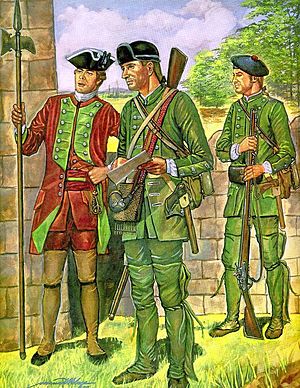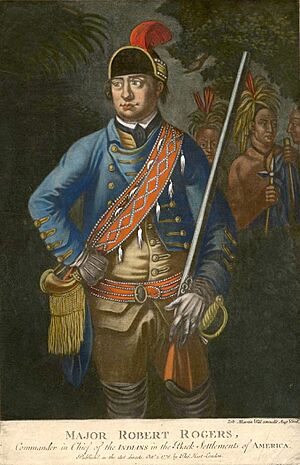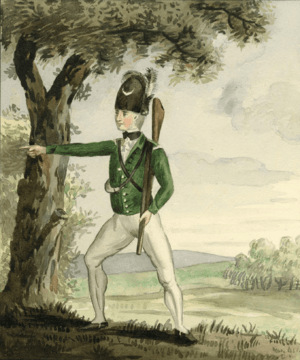Rogers' Rangers facts for kids
Rogers' Rangers was a special group of soldiers from the Province of New Hampshire who worked with the British Army during the French and Indian War. This war was also known as the Seven Years' War in other parts of the world. Led by Major Robert Rogers, these soldiers were like early special forces. They were very good at scouting, gathering information about the enemy, and fighting in the wilderness.
Rogers trained his men with special rules for fighting in the woods, which were very effective. Because they were so successful, their group grew from one company to many, with over 1,200 men at its biggest! They became the main scouting team for the British in America. Rogers' Rangers were officially ended in 1761.
Later, during the American Revolutionary War, the group was brought back to fight for the British. However, some former Rangers actually joined the American side and fought against the British! Today, some military units, like the Queen's York Rangers (1st American Regiment) in Canada and the U.S. Army Rangers, see themselves as following in the footsteps of Rogers' Rangers.
Quick facts for kids Rogers' Rangers |
|
|---|---|

To Range the Woods, New York, 1760, Unknown artist
|
|
| Active | 1755–1763 |
| Country | |
| Allegiance | |
| Branch | British provincial unit |
| Type | Auxiliaries |
| Role | Special operations Maneuver warfare Guerrilla warfare Skirmishing |
| Size | Nine companies (in the regiment) |
| Garrison/HQ | Fort William Henry (1755–1757) Rogers Island (1757–1763) |
| Engagements | French and Indian War
Pontiac's War (1763–1766)
|
| Commanders | |
| Notable commanders |
Lieutenant Colonel Robert Rogers Lieutenant Colonel James Rogers Captain William Stark Lieutenant John Stark |
Contents
Rogers' Rangers in the French and Indian War
Rogers' Rangers started in 1755 as a company of soldiers from New Hampshire. They were part of a long history of similar groups in New England. Their main job was to fight in the French and Indian War in the border areas of the colonies.
The Rangers were led by Captain (who later became Major) Robert Rogers. They mostly operated around Lake George and Lake Champlain in New York. They were formed during the winter of 1755 at Fort William Henry.
These Rangers often went on raids against French towns and military bases. They traveled on foot, in boats, and even on snowshoes in the winter. A famous soldier named Israel Putnam, who would later be important in the Revolutionary War, fought alongside Rogers and even saved his life once.

Because Rogers' company was so useful, the British decided to create more ranger companies. By early 1758, there were fourteen companies, with about 1,200 to 1,400 men. This included three units made up entirely of Native American soldiers. Rogers was promoted to major and became the leader of all the Ranger companies.
First Battle on Snowshoes
On January 21, 1757, Rogers led 74 Rangers to surprise the French near Fort Carillon. They captured seven prisoners. Then, about 100 French and Canadian soldiers, along with their Native American allies, attacked them. Rogers' men had some losses but managed to retreat safely because the French didn't have snowshoes and struggled in the deep snow. The Rangers fought from high ground and behind large trees.
A company of Rangers was at Fort William Henry in 1757 when it was attacked. After the fort surrendered, the Rangers moved to Rogers Island near Fort Edward. This allowed them to train and operate more freely than other soldiers.
Second Battle on Snowshoes
On March 13, 1758, the Rangers were involved in another "Battle on Snowshoes." They first ambushed a French and Native American group, but then they were ambushed themselves. The Rangers lost many men in this fight.
The French at first thought they had killed Rogers in this battle because they found some of his belongings, including his military coat. However, he had escaped! This event led to the famous story of Rogers sliding 400 feet (about 120 meters) down the side of a mountain to the frozen surface of Lake George. No one knows for sure if this really happened, but the rock face is still called "Rogers' Slide" or "Rogers Rock."
Siege of Louisbourg
Four companies of Rogers' Rangers, about 500 men, arrived in Dartmouth, Nova Scotia, in April 1758. They were waiting to join the Siege of Louisbourg (1758). While there, they searched the woods to stop enemy raids. During the siege, the Rangers were among the first to land ashore. They fought against French and Mi'kmaq soldiers, capturing many and showing great bravery.
Carillon and Crown Point
Rogers' Rangers also fought in the Battle of Carillon on July 7–8, 1758. Later, on July 27, 1758, a British group, including some Rangers, was ambushed by French and Native American forces. Many British soldiers were killed or captured.
On August 8, 1758, near Crown Point, New York, another British force with Rangers was ambushed. In this fight, Major Israel Putnam was captured. It's said that he was saved from being burned at the stake by a French officer and a sudden thunderstorm.
Raid on Saint-Francis
In 1759, the Rangers took part in one of their most famous missions: the St. Francis Raid. They were ordered to destroy a Native American village called Saint-Francis in Quebec. This village was a base for attacks on British settlements.
Rogers led 200 Rangers deep into French territory. After successfully attacking and destroying Saint-Francis on October 3, 1759, Rogers' group ran out of food on their way back through the wilderness. They finally reached a safe spot at an abandoned fort called Fort Wentworth. Rogers left his men there and returned a few days later with food and help from the nearest British outpost.
Raid on Sainte-Thérèse
In the spring of 1760, the Rangers joined a campaign against Montreal. Before that, they successfully raided Fort Sainte Thérèse. This fort was important for supplying the French army. Rogers and his men burned the settlement and the fort. They then fought off French and Native American ambushes before returning to Crown Point with only small losses.
Montreal Campaign
Rogers' Rangers were part of the British forces moving towards Montreal in August 1760. Along the way, they helped capture the French island of Île aux Noix. The Rangers, along with other soldiers, dragged cannons through forests and swamps to surprise the French navy. Their cannons opened fire, causing the French ships to flee or surrender. With their supply lines cut, the French left the island. Soon after, the Rangers led the final advance on Montreal, which surrendered without a fight the next month.
Rogers' Rangers in Pontiac's War
After the French and Indian War ended, the Rangers were given the job of taking over Fort Detroit from the French. Most of the Rangers then went back to their normal lives.
However, in 1763, Rogers gathered some volunteers to help reinforce Detroit during Pontiac's War. When they arrived, a British commander decided to attack a Native American village. The British force, including Rogers' volunteers, was ambushed. Rogers' men played a key role in helping the British soldiers retreat safely back to Fort Detroit.
Rogers' Rangers in the American Revolutionary War
When the Revolutionary War began in 1775, Robert Rogers offered to help General George Washington. But Washington turned him down, worried that Rogers might be a spy because he had just returned from England. Rogers then offered his services to the British, who accepted. He formed new units like the Queen's Rangers and the King's Rangers.
Interestingly, some of his former Rangers fought for the American side under General Benedict Arnold around Lake Champlain.
Legacy of Rogers' Rangers
After the American Revolutionary War, Rogers' Rangers were given land for farming in what is now Prince Edward Island, Canada. During the War of 1812, a large training camp was built there for Rangers.
Today, the Queen's York Rangers (1st American Regiment) in the Canadian Army say they are descended from Rogers' Rangers. The U.S. Army Rangers also claim a connection to them. They even give copies of Rogers' "Rules of Ranging" to their students.
A New Hampshire historical marker in Haverhill also honors Rogers' Rangers.
Rogers' Rangers in Popular Culture
- The historical novel Northwest Passage (1937) tells the story of Rogers' Rangers' raid on the Abenaki town of St. Francis. A film based on the first half of the novel, also called Northwest Passage, was released in 1940.
- During World War II, the U.S. Army was interested in the tactics of British Commando units. Remembering the colonial Rangers, they decided to use the name "Rangers" for their own special units. These modern Rangers see Robert Rogers as their founder.
- The film Fort Ti (1953) features Rangers rescuing hostages at Fort Ticonderoga during the Seven Years' War.
- The TV series Turn: Washington's Spies (2014) shows Rogers' Rangers as a Loyalist group using spy information to ambush American patrols.
- In the video game Assassin's Creed: Rogue (2014), players can unlock a "raider outfit" that looks like the Rangers' green uniforms.
Notable Rangers
- Major Robert Rogers
- Captain James Rogers
- Captain John Stark
- Joseph Cilley
- Moses Hazen
- Jonathan Moulton
- Israel Putnam
- William Stark
- Simeon Thayer
- James Hackett
- Captain Nathaniel Hutchins


